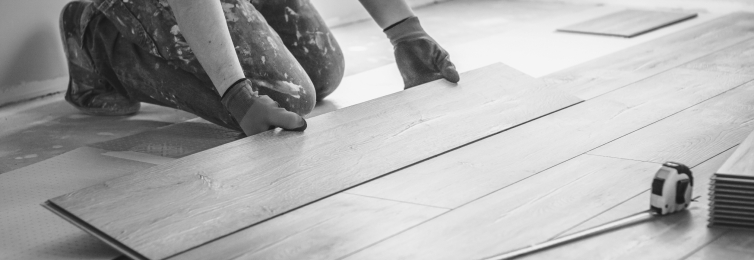Many highly regarded flooring subcontractors work best with teams that don’t exceed more than three to four members. The question is, how do small-scale subs build big safety strategies without breaking the bank?
Building a safety strategy from the ground up doesn’t always have to come with an exorbitant price tag. Even small teams can find the right balance of price and practicality without sacrificing the safety of their employees. Knowing the risks that differentiate your operations from the next flooring installation sub is a surefire way to provide your crews with the biggest bang for your buck.
What are the primary risks you should look out for? Depending on the type of flooring, our experts have offered answers to your risk-related questions.
Installing Tile
Q: What is the unique risk of transporting and lifting tile?
A: Manufacturers typically package hardwood flooring so that two people can easily lift it. The weight of boxes of tiles, on the other hand, quickly tips the scales, even though the packaging is relatively small by comparison. This makes lifting an important risk to manage when dealing with tile. Breaking down the tile boxes to manageable weights can offer relief—at the right price.
Q: What are some tactics I can implement to keep my lifters safe?
A: Using tile dollies can also help alleviate some of the strain, but when workers maneuver through a house, dollies might not be a feasible solution. The crew needs sensible alternatives to carrying heavy loads by themselves.
Teaching proper lifting techniques is crucial. Construction work is repetitive which will overwork muscles, ligaments, and tendons in workers both young and old. Rather than learning to “muscle” the items they pick up, workers must rely on proper lifting techniques to avoid injury. In training, ensure employees understand why these techniques protect against strain.
Q: Is there any other inexpensive equipment I can provide my employees?
A: Kneepads can provide a cost-effective form of relief from the pressure of kneeling on hard floors while laying tile. Whether designed for contractors or repurposed from old sports equipment, comfort is the ultimate goal.
Additionally, employees who make periodic stretching a regular part of their daily routines ward off shoulder strain at no additional cost.
Installing Carpet
Q: How can my team plan ahead for new carpet jobs to save both time and energy?
A: When installing new carpet and lugging heavy rolls, it seems like the risk of strains and pains are inevitable. Don’t make it harder than it needs to be. Start with pre-cutting the pieces at the shop, based on customer diagrams, so the crew lifts pieces as small as possible. Expect moving furniture to be a part of the day’s work, so bring along proper lifting tools to prevent back injuries or review safe lifting techniques before starting.
Additionally, ensure you have the manpower you need to get the job done right without undue stress. Plan the bigger jobs accordingly, and make sure the size of the crew on a given day fits the size of the job.
Q: Should I spring for a carpet cart? Is it a sound investment?
A: Yes, subs who invest in carpet carts (around $100) see big returns. Many have a hard time justifying the initial cost, until they experience the relief their crew gets from it. If all else fails and the crew needs to resort to good, old-fashioned lifting, be sure they lift in unison.
Q: What are some other useful installation tools to implement?
A: For the installation itself, many subs have heard of the power stretcher but still heavily rely on kickers. While acceptable for small jobs like closets, the kicker should otherwise be “kicked out” of large rooms. Kickers leave subs at risk of blowing out their knees or enduring other related injuries. While perhaps the most expensive of the safety strategies, power stretchers can save your team in the long run.
Installing Hardwood
Q: Why invest in a better saw guard?
A: When every penny counts, a $100 investment in a floating saw guard might seem a bit pricey. Saws already come with guards. Why upgrade if you don’t have to? It’s important to remember that every tool is an investment, and in order to get the most out of their usage, proper care is imperative. Even the most cautious worker can’t eliminate the possibility of losing a digit to a rotating blade. The unthinkable can happen to the most experienced user in a split second, and a floating guard’s ability to self-adjust to the thickness of the material being cut makes it a best bet.
Working on one’s hands and knees day in and day out wears on the body. Transporting and lifting can put serious strain on the body, leaving workers at great risk of hernias. However, injuries and the accompanying loss of productivity or rising workers’ compensation rates can be easily avoided when we’re taking heed to our bodies needs. Take a closer look at the opportunities you have to protect your crew with a safety strategy and eliminate risk no matter the type of flooring you need installed.




 Find an
Find an